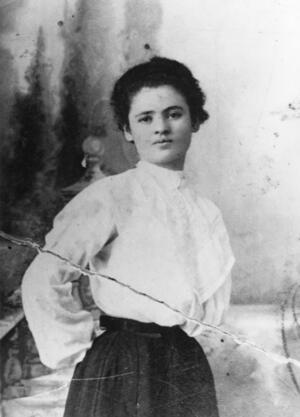Clara Lemlich Shavelson
Clara Lemlich was born in 1886 in the Ukraine. Like most girls, she was taught Yiddish but had no other Jewish schooling. When Lemlich’s parents learned that the local public school refused to admit Jews, they were so angry at the Russian government’s anti-Semitism that they forbade her to speak Russian or read Russian books. But Clara was determined to study. She earned money for books by sewing buttonholes on shirts and writing letters in Yiddish for illiterate mothers to send to their children in America. A young neighbor also lent her political pamphlets that introduced her to revolutionary ideas.
When the Lemlichs immigrated to New York City in 1903, 17-year-old Clara found work in a garment shop. Infuriated by the poor conditions, she began organizing women into the new International Ladies Garment Workers Union (ILGWU). The male workers who dominated the union resisted her efforts, but Lemlich warned them that their union would never get off the ground until they included women. Over the men’s objections, she brought her female coworkers out on strike again and again between 1907 and 1909.
In November 1909, after months of strikes in individual garment shops across New York during which she had been beaten and arrested multiple times, Lemlich helped spark the general strike known as the “Uprising of the 20,000.” Insisting that she be allowed to address a strike meeting at New York’s Cooper Union, her words ignited the long-simmering resentment of tens of thousands of young immigrant working girls like herself. Between thirty and forty thousand young women garment workers—predominantly Jewish immigrants—walked off their jobs over the next few weeks. It was a bitter, only partially successful strike, but it changed the labor movement by proving the effectiveness of women as union members.
When Lemlich was blacklisted from New York garment shops following the Uprising, she turned her energies to the suffrage movement, helping to found the Wage Earners League for Woman Suffrage. She was eventually fired from her position as organizer for refusing to moderate her radical politics to fit the more conservative vision of most middle-class suffragists.
In 1913, Lemlich married printer Joe Shavelson; the couple had three children. Clara brought her organizing skills and economic analysis to the domestic realm and began organizing wives and mothers around such issues as housing, food, and public education. She was a leader in the kosher meat boycotts of 1917, protesting rapid price increases, and in the rent strike movement that swept New York City in 1919 when a postwar housing shortage raised the cost of decent housing.
In 1926, Clara joined the Communist Party and helped to found the United Council of Working-Class Housewives, which helped the wives of striking workers raise funds, gather food, and set up community kitchens and cooperative child care. Organizing housewives proved so effective that in 1929 she helped create the United Council of Working-Class Women (UCWW). She argued that the working-class housewife was as important a participant in the class struggle as her wage-earning relatives.
In 1935, the UCWW changed its name to the Progressive Women’s Councils and began building a coalition with a wide range of women’s organizations to protest the increasing cost of food and housing. With Clara Shavelson as its president, the Progressive Women’s Councils mounted a meat boycott that shut down 4,500 New York City butcher shops. The housewives’ movement eventually forced governments to increase regulation of food and housing costs and expand public housing.
In 1944, after her husband became ill, the 58-year-old Shavelson returned to the garment trade and to the union movement. During the 1940s, she served on the American Committee to Survey Trade Union Conditions in Europe and spoke out against nuclear weapons as an organizer for the American League Against War and Fascism. At the age of 81, Shavelson moved into the Jewish Home for the Aged in Los Angeles. During her years there, she persuaded the administrators to honor the grape and lettuce boycott then being promoted by the United Farm Workers and helped the orderlies to organize a union. She died in 1982, at age 96.
This biography is adapted from Annelise Orleck’s article on Clara Lemlich Shavelson in Jewish Women: A Comprehensive Historical Encyclopedia.



